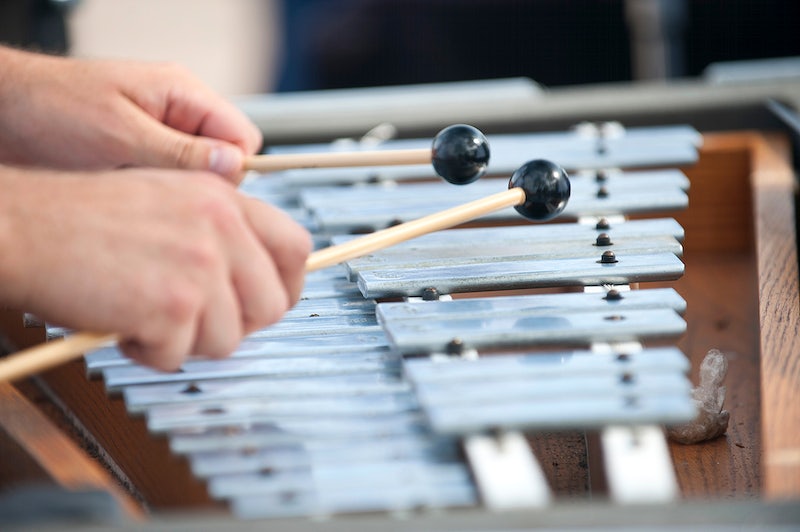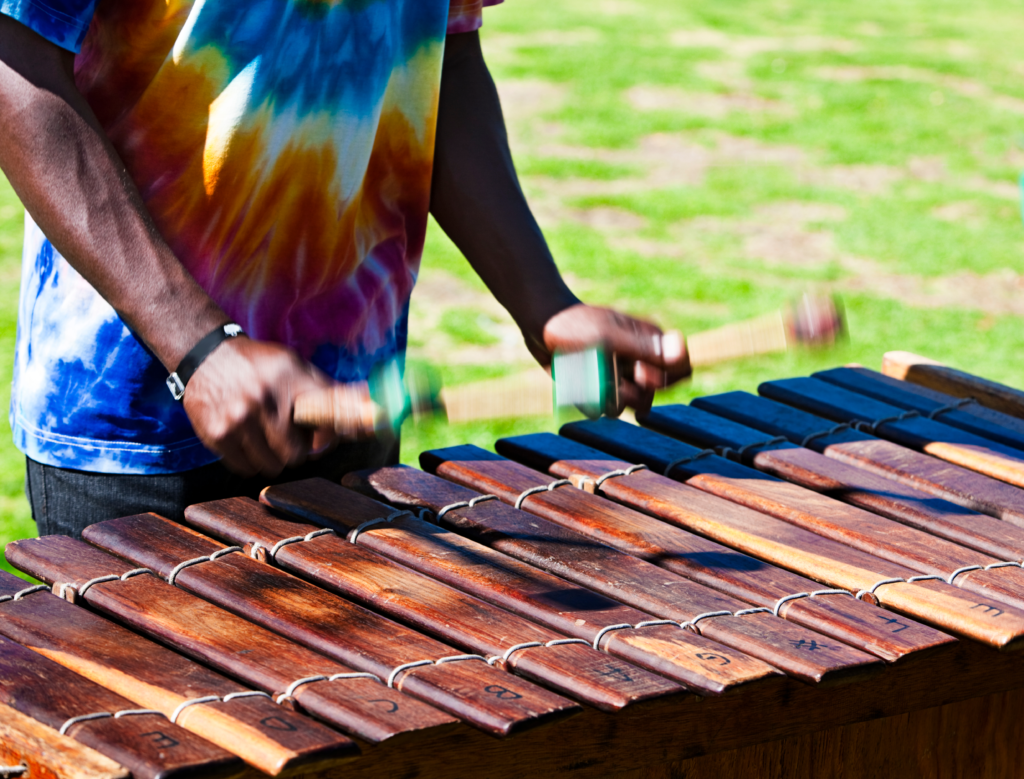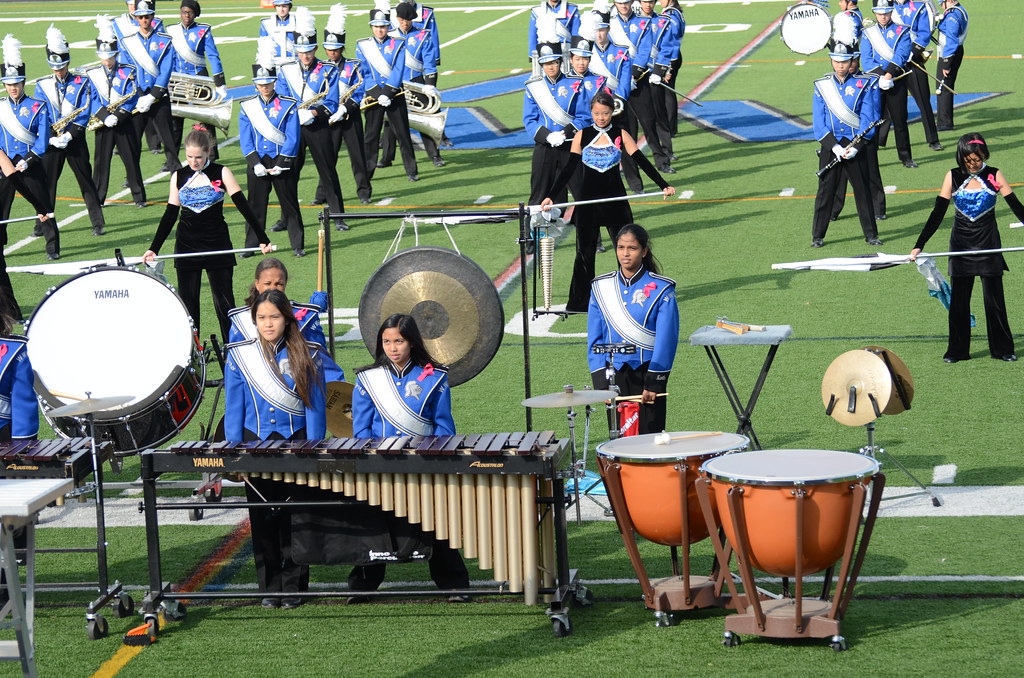How To Set Up A Front Ensemble

Ah, the front ensemble! The unsung hero of many a marching band. Often ignored, sometimes unheard, but always quietly bringing a unique and important color to the group. So, how exactly do you set one of these things up?
The typical full front ensemble configuration includes a line of boards in the front row made up of five marimbas in the center and a vibraphone on each end. And a back row that could include xylophone, auxiliary percussion, synthesizers, timpani, electric bass, drum set, vibraphones, and more.

Instruments That Make Up a Front Ensemble
Before any more decisions are made, you have to know which instruments you’re going to include in your front ensemble. There are a few essential instruments to include, and a large number of others that aren’t strictly necessary but are still wonderful to have if possible. Let’s go through them!
1 – Marimba
Arguably the single most important instrument in the front ensemble is the marimba. An incredibly versatile instrument, it can play anything from low chordal support to fast, virtuosic, melodic runs, all with its rich, characteristic sound.
2 – Vibraphone
The vibraphone is the marimba’s partner in crime. Its range is smaller, but its sharper metallic sound and ability to sustain notes make it an important piece of the ensemble. Vibraphones are often used for more chordal and simpler melodic passages to hold down the theme while the marimbas embellish, though they can also join in on the fast runs when they need to be emphasized.
3 – Suspended Cymbal
While not really functioning as a standalone instrument, every keyboard percussion instrument in the front ensemble should have an attached suspended cymbal. These are used to provide support for dynamic swells, as well as isolated hits to support important accents in drum breaks.
4 – Auxiliary Percussion
The most unsung members of the most unsung section, auxiliary percussion nevertheless plays a very important role. Ranging from various cymbals, to concert bass drums, to triangles, to glockenspiels, auxiliary percussion provides all the little sounds and effects that you really can’t get anywhere else in the ensemble.
5 – Xylophone
If you’ve covered the basics and you’ve got extra spots to fill, the xylophone is an excellent addition to the ensemble. Its somewhat harsh and piercing timbre means the xylophone can’t be used in every situation (imagine someone operating a jackhammer during a Ravel symphony and you’ll get my meaning), but it really shines on fast and energetic sections. However, given the precision of the instrument and the difficulty of finding any two that are perfectly in tune with each other, you probably won’t want more than one.
6 – Synthesizer
One of the more recent additions to the sound of the front ensemble, synthesizers have become fairly common in marching bands with the players and budget to include them. They allow for more sonic experimentation, often creating some very unique sounds that can really make the group stand out. They serve a highly textural purpose in the marching band world and rarely focus on melodic runs.
7 – Timpani
Any percussionist will tell you that timpani can be a pain to lug around. However, they also provide excellent support to the low end of the sound. No other instrument combines pitch with the characteristic timbre of a drum quite like the timpani.
8 – Electric Bass
Probably the least common addition on this list, the electric bass can nevertheless be used to great effect by a capable arranger. Obviously very focused on the low end, having someone right up front supporting the low brass with their own unique sound can be a real boon to the ensemble.
9 – Drum set
There is an age-old debate over the inclusion of the drum set in a front ensemble.
I talk all about it in my article, Pros and Cons of Having a Drum Set In Marching Band.
Some people think it adds a unique sound to certain sections of the music. Some people find it corny and think it doesn’t fit with the marching band sound. Some people are in the battery and might be a little jealous that there’s some guy up front stealing their thunder.
Regardless of where you stand in this debate, there’s no denying that the drum set has a history with the front ensemble, and I would be remiss not to include it.

Front Ensemble Instrument Arrangement
Now that we have some ideas about which instruments to include in the front ensemble, let’s talk logistics. When deciding how to set up the ensemble, it’s important to keep in mind both the way the sound is going to reach the audience and the ease of getting everything on and off the field quickly.
Sound balance in marching band is a very physical process. The incredibly large physical space between the performers themselves, as well as between the band and the audience, means that the physical arrangement of the instruments has an impact on the “mix”, so to speak.
With this in mind, the front ensemble should be arranged with a focus on both volume and the content of the individual parts.
Most front ensembles are arranged roughly into two or three rows. Both front to back and side to side balance will need to be considered.
Row 1
The front row should definitely contain the marimba section. Marimbas are front and center because the are generally the quietest instrument in the front ensemble and usually have very interesting and important parts. They also are very visually appealing when playing in unison.
Most groups will have four to six marimbas, which should all be able to fit on the front row. If you have four then it’s common to put the lead vibraphone parts up front as well, generally on the ends of the line.
Within the front row, the lead marimbas should be in the center. Just like with the battery, you want your strongest players in the center where it’s easiest to listen in to them. The players in the center of the row will also sound a bit clearer to the audience, so the more complex parts should come from there.
While the lead vibraphones may have more complex parts and/or stronger players than the supporting marimbas at times, the nature of the vibraphone means it will always be easier to hear than the marimbas, so placing them on the ends is the natural choice.
Row 2
In a 3 row configuration, row 2 should be arranged according to the same principles as the front row and contain xylophone and vibraphones.
If there is a xylophone, it should be in the center, as its clarity and volume make it a natural focal point for the rest of the ensemble to listen in to.
The remaining vibraphones will typically be split on either side of the xylophone. If you have more than two in the back row, then they should expand outward based on part complexity and player strength just like the marimbas.
In a 2 row configuration, drum and xylophone should be most centered, then synths and electronics, then vibraphones as close to directly behind the front row vibraphones as possible (so they can hear each other), and any more auxiliary percussion on the ends.
Row 3
If your second row is full of keyboards, the third row is where everything else goes. Auxiliary percussion should be on the ends, along with the timpani. Drum set, if used, should be near the center. Any electronic instruments like synthesizer or bass should be in the center or near the center.
Mixing console
Finally, if you have amplification, there will typically be a mixing console near the center of the back row or behind the back row.
Front Ensemble Amplification
One other important consideration is how to make sure the audience hears all this! It’s no secret that the front ensemble is quieter than the rest of the band. The ideal fix is a sound system. All the mallet instruments can be mic’d, and electric instruments can be plugged in as well. The speakers should go on the edges of the ensemble and angle in towards the audience.
If a sound system isn’t feasible, then plexiglass is your best bet. A large sheet placed right under the resonators of marimbas and vibraphones and angled towards the audience will help to amplify and direct the sound a little bit.
Getting On and Getting Off The Field
Getting everything on and off the field quickly is also very important, especially in competitions where you have very limited time to do so. Everyone should be lined up in the correct order before getting on to the field. It’s a good idea to practice setting up and breaking down quickly so that everyone knows exactly what their jobs are beforehand.
Auxiliary percussion should be arranged on wheeled tables or racks, to ensure that all the instruments can be moved efficiently without losing any. Timpani are often placed on a large wheeled cart so that they can all be moved at once. Players with smaller instruments, or who require less set-up, should help those with more difficult jobs.
If you are using vehicles like a golf cart or ATV to move your equipment, make sure that you have permission to drive onto the field. Some stadiums are very particular about their field care and do not want big heavy trailers being driven over them. In that case, you might have to drive to the 50 on the track and unload from there.